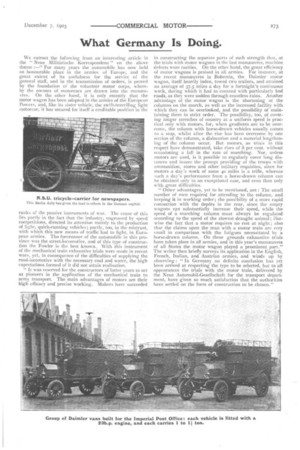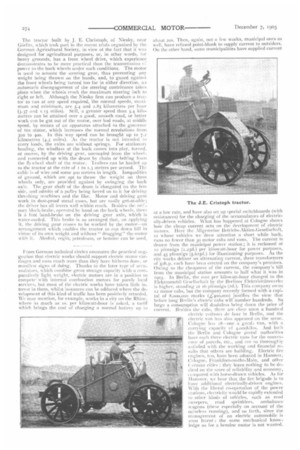What Germany Is Doing.
Page 17

Page 18

If you've noticed an error in this article please click here to report it so we can fix it.
We extract the following from an interesting article in the " Neue Militarische Korrespondenz " on the above theme :—" For many years the automobile has now held an honourable place in the armies of Europe, and the great extent of its usefulness for the service of the general staff, and in the transmission of orders, is proved by the foundation of the volunteer motor corps, whereby the owners of motorcars are drawn into the manceuvres. On the other hand, it is only recently that the motor wagon has been adopted in the armies of the European Powers, and, like its sister vehicle, the swift-travelling light motorcar, it has secured for itself a creditable position in the
ranks of the passive instruments of war. The cause of this lies partly in the fact that the industry, engrossed by speed competitions, directed its attention mainly to the production of light, quick-running vehicles; partly, too, in the mistrust, with which this new means of traffic had to light, in European armies. The forerunner of the automobile in this province was the street-locomotive, and of this type of construction the Fowler is the best known. With this instrument of the mechanical train exhaustive trials were made in recent wars, yet, in consequence of the difficulties of supplying the road-locomotive with the necessary coal and water, the high expectations formed of it did not attain realisation, " It was reserved for the constructors of latter years to act as pioneers in the application of the mechanical train to army. transport. The main advantages of motors are their high efficacy and precise working. Makers have succeeded
in constructing the separate parts of such strength that, at the trials with motor wagons in the last mameuvres, machine defects were rarities. On the other hand, the great efficiency of motor wagons is praised in all armies. For instance, at the recent manceuvres in Bohemia, the Daimler motor wagon, itself heavily laden, towed two trailers, and attained an average of 37.5 miles a day for a fortnight's continuous work, during which it had to contend with particularly bad roads, as they were sodden through ceaseless rains. Another advantage of the motor wagon is the shortening of the columns on the march, as well as the increased facility with which they can be overlooked, and the possibility of maintaining them in strict order. The possibility, too, of coverlog longer stretches of country at a uniform speed is practical only with motors, for, when gradients are to be overcome, the column with horse-drawn vehicles usually comes to a stop, whilst after the rise has been overcome by one section of the column, a dislocation and a material lengthening of the column occur. But motors, as trials in this respect have demonstrated, take rises of 8 per cent, without oacasioning a fall in the rate of marching. Nor, unless. motors are used, is it possible to regularly cover long distances and insure the prompt providing of the troops with ammunition, stores and other military requisites, since for motors a day's work of some 40 miles is a trifle, whereas. such a day's performance from a horse-drawn column can be obtained only in an exceptional case, and even then only with great difficulties.
" Other advantages, yet to be mentioned, are : The small number of men required for attending to the column, and, keeping it in working order; the possibility of a more rapid. connection with the depots in the rear, since the empty wagons can substantially increase their speed, while the speed of a marching column must always be regulated according to the speed of the slowest draught animal; likewise the fact that a motor requires no rest at night ; also that the claims upon the man with a motor train are very small in comparison with the fatigues necessitated by a horse-drawn column. On these grounds exhaustive trials have taken place in all armies, and in this year's manceuvres of all States the motor wagon played a prominent part." The writer then briefly surveys its application in the English, French, Italian, and Austrian armies, and winds up by observing ; " In Germany no definite conclusion has yet been arrived at respecting the type to be selected, but to all appearances the trials with the motor train, delivered by the Neue Automobil-Gesellschaft for the transport department, have given so much satisfaction that the authorities have settled on the form of construction to be chosen."
The tractor built by J. E. Christoph, of Niesky, near Got-lit', tvhich took part in the recent trials organised by the German Agricultural Society, in view ot the fact that it was designed for agricultural purposes, or, in other words, for heavy grounds, has a front wheel drive, which experience demonstrates to be more practical than the transmission o: powcr to the back wheels under such conditions. The motor is used ro actuate the steering gear, thus preventing any weight being thrown on the hands, and, to guard against the front wheels being turned too far in either direction, al automatic disengagement of the steering contrivance takes place when the wheels reach the maximum steering lock to right or left. Although the Niesky firm can produce a tractor to run at any speed required, the normal speeds, maximum and minimum, are 5.4 and 2.85 kilometres per hour (3.37 and 1.15 miles). Still, a greater speed than 5.4 kilometres can be attained over a good, smooth road, or better work can be got out of the motor, over had roads, at middle speed, by means of an apparatus attached to the governor of tne motor, which increases the normal revolutions from 300 to 400. In this way speed. can be brought up to 7.2 kilometres (4.5 miles). As the tractor is not intended to carry loads, the axles are without springs. For stationary hauling, the windlass at the back comes into play, turned, oh course, by the driving gear, uncoupled front the wheel.. and connected up with the drum by chain or beltingfloat the flywheel shaft of the motor. Trailers can be hauled up to the tractor at the rate of i to 1.3 metres per second. Mt cable is of wire and some 400 metres in length. Inequalities of ground, which are apt to throw the weight on three wheels only, are provided against by swinging the back axle. The gear shaft of the drum is elongated on the free side, and admits of a pulley being keyed on to it for driving threshing machines and the like. Motor and driving gear work in dust-proof metal cases, hut are easily get-at-able; the driver has all levers well within reach. Besides the ordnary block-brake, operated by hand on the back wheels. there is a foot !and-brake on the driving gear axle, which is water-cooled. This brake is so arranged that, on applying it, the driving gear ceases to be worked by the motor—an arrangement which enables the tractor to run down hill in virtue of its own weight and without " dragging" the motor with it. Alcohol, ergin, petroleum, or benzine can be used, From German technical circles emanates the practical suggestion that electric works should support electric motor carriages and vans much more than they have hitherto done, or manifest signs of doing. Thanks to the later type of accumulators, which combine great storage capacity with a comparatively light weight, electric motors are in a position to compete. with internal combustion motors for purely local services, but most of the electric works have taken little interest in them, whilst instances can be adduced where the development of this kind of traffic has been positively retarded. We may mention, for example, works in a city on the Rhine, where as much as is. per kilowatt-hour is asked, a tariff which brings the cost of charging a normal battery up to about 20S. Then, again, not a few works, municipal ones as well, have refused point-blank to supply current to outsiders. On the other hand, some municipalities have supplied current at a low rate, and have also set up special switchboards (with resistances) for the charging of the accumulators of electrically-driven vehicles. What has happened at Cologne shows how the cheap current acts on the development of electric motors. Here the Allgemeine Betriebs-Aktien-Gesellschaft, to whose vehicles we drew attention a short while back, runs no fewer than 3m) motor cabs and vans. The current is drawn from the municipal power station; it is reckoned at LO Wettings (1.25d.) per kilowatt-hour for power purposes, and 45 pfennigs (5,625d.) for illuminating purposes. As the city works deliver an alternating current, three transformers of soh.p. each have been erected on the company's premises. Owing to the cheapness of the current, the company's bill from the municipal station amounts to half what it was in 1903. In Berlin, the cost per kilowatt-hour charged to the Elektromohil licsdIschaft by the Berliner Elektrizitiitswerke is higher, standing at 16 pfunnigs (2d,). This company owns 12 motor cabs, but the company recently formed with a capital of 8,000,00n marks (400,000) justifies the view that before long Berlin's electric cabs will number hundreds. So large a consumption will doubtless bring down the price of current. Besides the cabs, there are close upon a hundred electric voitures de lime in Berlin, and the electric van has also appeared on the scene. Celogne has 18—one tt gottd., van, with a carrying, capacity of 4,000kilos. And bo:h the Berlin and Cologne postal authorities have each three electric vans fur the conveyer-ire of parcels, etc., and ore so thoroughly satisfied with the working and financial results that others are building. Electric fire engines, too, have been adopted in Hanover, Cologne, Frankfort-off-the-Main, and. Other ( /Titian cities : they leave nothing to be desired on the score of reliability and economy, et:moared with horse-drawn vehicles. As for Ilanoyer, we hear that the lire brigade is to have additional electrically-driven engines. With the liberal co-operation of the power t:tations, electricity would be rapidly extended to other kinds of vehicles, such as road sweepers, road sprinklers, ambulance wagons (these especially on account of the noiseless running), and so forth, since the management of an electric automobile is soon learnt : the same mechanical knowledge as for a benzine motor is not wanted.






















